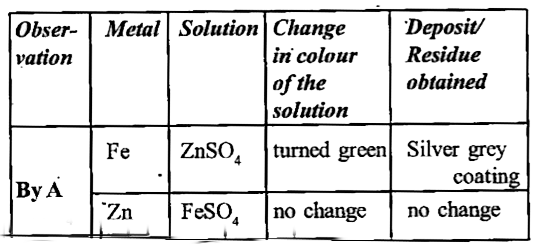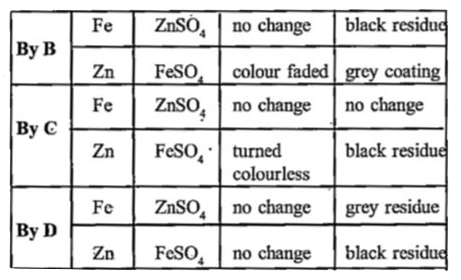A student prepared solutions of (i) an acid and (ii) a base in two separate beakers. She forgot to label the solutions and litmus paper is not available in the laboratory. Since both the solutions are colourless how will she distinguish between the two ?
As both the solutions are colourless and student is in laboratory, she can use chemical indicator like phenolphthalein or natural indicators like turmeric, china rose, etc., to distinguish between the two.
Topper's Solved these Questions
- BOOK - OSWAL PUBLICATIONCHAPTER - ACIDS, BASES AND SALTSEXERCISE - Board Corner (Single Answer Type Questions)18videos
ACIDS, BASES AND SALTS
- BOOK - OSWAL PUBLICATIONCHAPTER - ACIDS, BASES AND SALTSEXERCISE - Board Corner (Long Answer Type Questions)3videos
ACIDS, BASES AND SALTS
- BOOK - OSWAL PUBLICATIONCHAPTER - ACIDS, BASES AND SALTSEXERCISE - NCERT Corner (Exercise Questions ) (Short Answer Type Questions)15videos
ACIDS, BASES AND SALTS
- BOOK - OSWAL PUBLICATIONCHAPTER - CARBON AND ITS COMPOUNDSEXERCISE - CREATING BASED QUESTIONS23videos
CARBON AND ITS COMPOUNDS
Similar Questions
A student prepared solutions of NaCl, Na2CO3andNH4Cl. He put them separately in three test tubes. He forgot to label them. All solutions were colourless . How should he proceed to know the solutions present in the three test tubes ?
View SolutionTwo salts are dissolved in water separately. When phenolphthalein is added to the two solutions, one solution turned pink and the other solution was colourless. How do you justify this ?
View Solution
Knowledge Check
- Question 1 - Select One
A is an aqueous solution of Acid and B is an aqueous solution of base. These are diluted separately. Then
ApH of P increases while that of Q decreases till neutralisation .BpH of P decreases while that of Q increases till neutralisation .CpH of both P and Q decrease.DpH of both P and Q increase . - Question 2 - Select One
Aqueous solution of two compounds M1−O−HandM2−O−H are prepared in two different beakers . If electronegativity of M1=3.4,M2=1.2,0=3.5andH=2.1, then the nature of two solution will be respectively
Aacidic , acidicBacidic basicCbasic , basicDbasic acidic - Question 3 - Select One
Two solutions of KNO3 and CH3COOH are prepared separately. The molarity of both is 0.1M and osmotic pressure is P1 and P2, respectively.
The correct relationship between the osmotic pressure isAP2>P1BP1=P2CP1>P2DP1P1+P2=P2P1+P2
Abhinav is a student of class IX. One day all the students were performing experiments in the science laboratory. Just then, the chemistry teacher, Mrs. Prasad, came to the laboratory. She had three beaker in her hands labelled A, B and C. All the beakers contained colourless liquids which looked exactly the same. Mrs. Prasad turned to the students and said that one of the beakers contained a pure substance whereas the other two beakers contained solutions of the same solute in the same solvent but different concentrations. She also told the students that the weight one of the three beakers A, B and C were 110g, 120g and 100g respectively. Mrs. Prasad wanted one of the students to find out experiementally which beaker contained a pure substance and which two beakers contained solutions. She also wanted them to show experimentally two properties which could tell why the solutions are considered mixtures, even though they are homogeneous substances. Mrs. Prasad wanted one of the the students to find out experimentally which beaker contained a pure substance and which two beakers contained solutions. She also wanted them to show experimentally two properties which could tell why the solutions are considered mixtures, even though they are homogeneous substances. Mrs. Prasad allowed them to use any required apparatus from the laboratory for the purpose. Abhinav offered to perform the experiements to distinguish between the pure substance and solutions and also to show experimentally why solutions are considered mixtures.
(a) What did Abhinav do to find out which of the given liquids is a pure substances and which liquids are solutions ? What were the observations made by Abhinav ?
(b) Whay did Abhinav conclude form the above observations ?
(c) Which property of the pure substance is exhibited by this experiment ?
(d) Which properties of a solution are exhibited in this experiement ?
(e) What values are displayed by Abhinav in this episode ?View SolutionRadha is a student of class X in a city school. One day Radha was doing practicals in the science laboratory of her school. Just then her science teacher, Mrs, Chopra, came to the laboratory with a beaker of a coourless solution. She told Radha that the colourless solution contains the nitrate of a metal which is usually alloyed with 24 carat gold to make 22 carat gold for ornaments. Mrs. Chopra asked Radha to device a method to obtain the dissolved metal from the solution in the solid form. Radha started thining about it. After some time Radha took a certain wire from the laboratory, cleaned it and placed it in the colourless solution in the beaker. She allowed this wire to remain immersed in the solution for a considerable time. Radha noticed a gradual change in the colour of solution in the beaker and saw a thick deposit of a substance on the wire kept in the solution. Radha was happy that she had done her job well.
(a) Name the metal whose nitrate solutioin you think is given in the bearker? Why do you think so?
(b) What was the nature of wire placed by Radha in the given solution? Why was this particular wire used?
(c) What change in the colour of solution was obsered by Radha in the beaker and why?
(d) Which substance was deposited on the wire placed in the solution?
(e) Which chemical reaction is utilised by Radha in this process? Why does this reaction occur?
(f) What values are displayed by Radha in this episode?View SolutionFour students A, B, C, and D took aqueous solutions of zinc sulphate and iron sulphate in two test tubes I and II and dropped metal pieces of Iron and Zinc in the two solutions. After several hours, they made observations and recorded their findings in the form of a table given below:


Who reported the correct observation?View SolutionA student was given two metal strips X and Y alongwith colourless nitrate solution to perform two separate displacement reactions. When the student placed metal strip X in nitrate solution for a considerable time he observed hat the solution turned blue and coating of silver meal was formed on the strip. And when the student immersed meal strip Y in silver nitrate solution for an equal time, the observed that the solution turned light green with the fomation of a coating of silver meal on the strip. The correct conclusion of the student about the identity of meals X and Y is:
View SolutionA coloured solution known to contain two metal ions, was treated with excedss cold sodium hydroxide solution. When filtered a whitish solid, slowly changing to brown, was retained on the filter paper and a colourless solution collected as the filtrate. dropwise addition of hydrochloric acid to the filtrate produced a white ppt. which dissolved in excess acid. treatment of the residue on filter paper with a solution of strong oxidier produced a reddishh-violet solution.. indicate any pairs of ions:
View Solution

